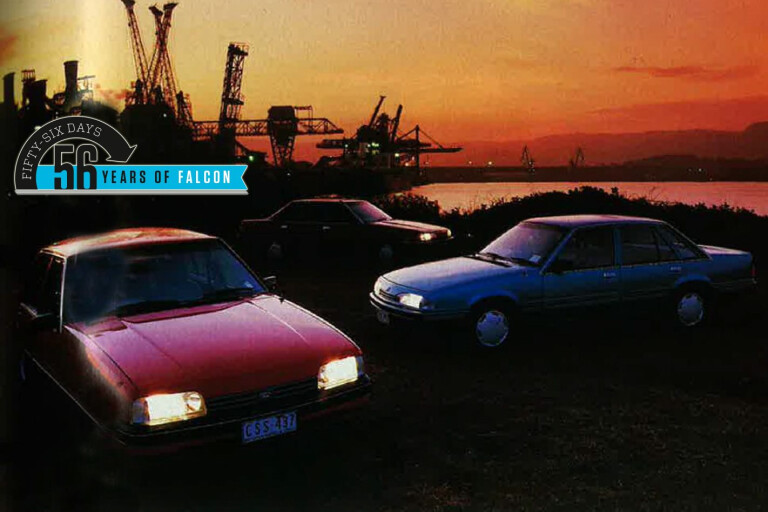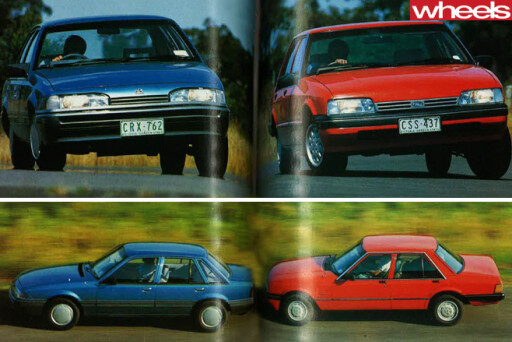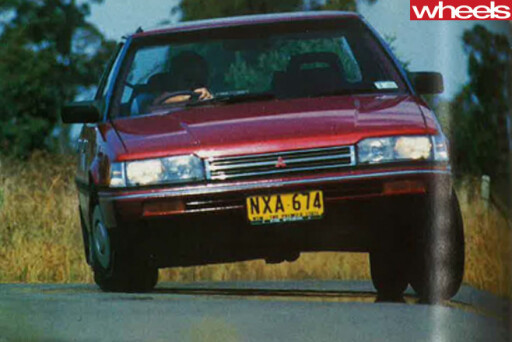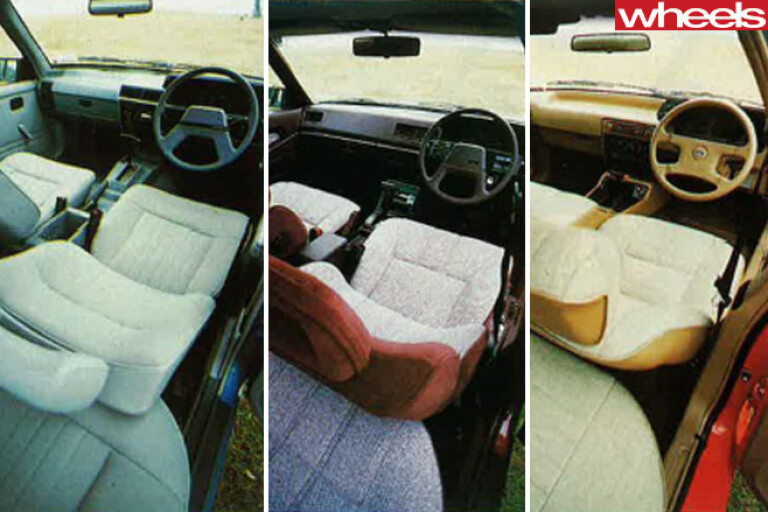
First published in the June 1986 issue of Wheels magazine, Australia's best car mag since 1953.
Was this the start of the decline for the big, rear-drive Aussie-made six-cylinder?
What is the front-drive four-cylinder Magna doing in a direct comparison with the newest family sixes from Ford and Holden? Doing very nicely, that's what it's doing. Report by Mike McCarthy.
MAGNA RULES, okay! The reigning WHEELS COTY winner was motoring's success story of 1985, and deservedly so. Its bold concept, advanced design and thorough development not only meant the Magna improved four-cylinder class standards but also meant it was the first four ever capable of competing outside its own sphere. The Magna had the space, pace and refinement to directly challenge the traditional family sixes.
It wasn't only on the best-seller charts that the wide-bodied Mitsubishi made its mark. The Magna achieved the rare distinction of virtually unanimous acclaim from the motoring press. There were at least two car makers who'd have to disagree - at least in public - with the press and people's choice. Ford and Holden could only stand and watch, first with blissful indifference, and then with increasing concern as the Magna stole the spotlight. They saw it surge to a dominating position on the four-cylinder sector, scoring points off the Telstar and Camira among others along the way. The hurt spread as the Magna slipped across the border into six-cylinder territory to poach sales.
Was nothing sacred? It was only then that Ford and the General realised they had a different fight on their hands. In addition to scrapping with each other, they found their flanks vulnerable to the big-bodied four-banger. In defence they can point to the probability that the total number of six-cylinder sales lost to the Magna is fairly small. Main reason for that is that a large majority of six-cylinder sales go to company cars and fleet deals, which are fields where Mitsubishi doesn't choose to compete as intensely. But industry watchers believe that the Magna's impact on private (ex six-cylinder) buyers is significantly greater than the Big Two care to admit. Its influence is certainly even greater than the sales numbers might suggest because behind the scenes it's a trend setter which has affected coming designs from other car makers.
Perhaps most importantly, if the proposed tax on company cars becomes reality the Magna is going to be the first choice for those forced out of Falcons and Commodores. The first round of the Magna -versus-the-rest stoush was fought with leaded petrol. But the conditions and the contenders changed somewhat with the continuing price spiral and the switch to unleaded fuel.
Which brought us to the question of how the latest Magna stands in relation to the mildly modded Falcon and the facelifted Commodore with its brand new powertrain. Three cars, seven days and about 1000 kilometres later we had found the answers.
 Prices/equipment
Prices/equipment
Our line-up consisted of the Commodore Executive, the Ford Falcon GL and the Magna SE, all autos. They came to the line with a broad spread of list prices ranging from the Executive's base $15,150 to the SE's $16,270 with the GL almost splitting the difference at $15,513.
The Executive is one of those special deals (like the Vacationer) that the General packages so well.
In this case the base figure includes power steering and automatic transmission, so represents a saving of more than $250 against the equivalent optioned-up Commodore SL. The test Executive added $130 tinted windows, $69 metallic paint and $1207 air conditioning to bring its total to $16,556.
At $15,513 the Falcon GL already included the optional 4.1-litre carburettor engine and auto trans. But the $538 power steering and $1190 air conditioning brought it to $17,241 and the same general spec level as the others; though not the same equipment level.
The automatic Mitsubishi Magna's $16,270 figure blew out to about $17,200 by the time air conditioning was added, and you'd need another $483 in hand if you opted for power steering which the test car unfortunately lacked. However the sticker shock is softened with the knowledge that the SE is much better equipped than the Executive and GL. Among the middle Magna’s standard features are four-wheel disc brakes, which together cost over $550 extra for the Executive. The Falcon’s $693 all-disc option includes a limited-slip differential, and one can’t get full instrumentation without specifying the whole $714 ‘S’ Pack which also brings sports styled road wheels, tilt steering column, driver’s lumbar adjustment and cushion tilt, driver’s left footrest, tweed style fabric, fog lamps and (in Ford’s words) “racey black stripes”. That means the GL will set you back about $18,594 to rival the Magna SE’s features and throw in a few other goodies besides. However that’s getting a bit beyond the point of the middleclass exercise.
Aside from standard power steering and auto trans, the Executive’s equipment and options list parallels the Commodore SL’s in every respect. It’s reasonably well featured as standard with remote boot lid release, driver’s footrest, driver’s cushion height adjustment, cloth trim and band tinted windscreen. But to get on par with the Magna SE’s equipment level, one really would have to start with the upmarket $16,798 Berlina and option on from there.
So far as fittings and features are concerned, the problem for Commodores and Falcons is simply that the Magna outdoes them. In fact on a straight equipment level they compete more closely with the base GLX Magna; except that it lists at under $14,300 as an automatic, plus $483 for power steering. It's quite reasonably appointed with tachometer, tilt column, tinted windows, driver's lumbar adjustment, passenger grab handles (lacking in the Executive and GL) and more. The SE adds velour trim, four-speaker electronic tune sound system, seven-way driver's seat, front passenger's lumbar adjustment, foot rest, remote boot lid release and centre console among its many niceties. What it all means in the equipment context, of course, is that the Magna SE justifies its higher initial price by providing much more than the others.
Performance
Performance equations have changed of course, with the advent of unleaded petrol. Some makers adapted existing engines to the new technology, Ford and Mitsubishi among them. Others, like Holden, found it too difficult and/or expensive to improve their old engines for ULP, so turned to new powerplants.
Deceptively small but intricate modifications to the ignition, intake, exhaust and elsewhere have enabled the Falcon and Magna engines to survive the unleaded trauma with minimal loss of
performance. The Falcon is a case in point. The carburetted 4.1-litre model's power is down by 5.5 kW and its torque by 19 Nm, but the respective peaks occur 150 and 400 rpm lower than before. The Magna on the other hand maintains its previous power level at unchanged revs but has lost seven Nm while raising the point of peak torque by 400 rpm.
Where the Falcon keeps its three engine line-up (with slow selling carby 3.3- litre and expensive injected 4.1 as well as the carby 4.1), the Magna sticks to its one and only carburetted 2.6-litre trojan. The Commodore too now has only one engine; the old 2.8 and 3.3 variants have been replaced by the supersports injected three-litre which GMH buys from Nissan. Though the three-litre develops 19 Nm less than the previous injected 3.3 and peaks at a lofty 3600 rpm(400 more than before) maximum power is up by eight kW, albeit at 800 rpm higher than its predecessor.
 Since the Magna has the smallest, least powerful engine in this group and isn’t much lighter than the Holden Commodore, you’d be right in summising that it runs third. That doesn’t imply that it’s sluggish, it’s the opposite: it’s very aggressive and willing.
Since the Magna has the smallest, least powerful engine in this group and isn’t much lighter than the Holden Commodore, you’d be right in summising that it runs third. That doesn’t imply that it’s sluggish, it’s the opposite: it’s very aggressive and willing.
For such a big four the engine is outstandingly smooth and free-revving. It’s torquey enough to pull strongly from low revs and makes the most of its slick and high-geared four-speed automatic to be able to keep the Falcon honest. In fact in the standing start acceleration runs the Mitsubishi pipped the big Ford up to about 90 km/hand only then slipped slightly behind to cover the standing 400 metres just 0.3 of a second in arrears.
The Falcon's no slug either. There's still a suggestion of laziness in the way it bowls along with that time-honoured big-car feel. The engine sometimes seems a bit agricultural because it's more a stayer than a sprinter and is in its element at low to middling revs. If it had a tachometer it'd be redlined at a comparatively low 4250 rpm.
The real nature of the 4.1 and the strength of its performance can be seen from the fact that not only is the Falcon by far the heaviest of this trio, almost 300 kg more than the Commodore, but also that it has the tallest gearing in its three speeds. True, the overdrive fourths of the Commodore and Magna are taller again, but in first, second and direct (top) gear the Ford has the much longer legs needed to wring respectable speeds from its more constrained rev range.
The Commodore's engine and performance are in utter contrast to the Falcon's. A real rev-head, the injected three-litre is tractable but gives its best when working in the middle to high end of the rev scale.
Its revs and performance prove this is a sports engine par excellence. At least, that's the way it ought to be. Not with this particular test car however. Whether tired from the demanding test schedule or just simply off song, the Executive went a bit fiat at the top end.
To keep the comparison in proper perspective therefore, we've recalled the performance figures from WHEELS May '86 test of the mechanically identical Calais. From this it can be seen that the combination of the most powerful, most free-revving engine with a well geared four-speed transmission in a car of comparatively low mass gives the healthy Holden outstanding performance potential. Exploit that potential and it fairly flies, more like a sports car than an easy driving family sedan.
Besides being quickest the Commodore is fastest of the three. Even as an automatic it really gets up there. We saw over 190 km/h on the corrected speedo, with a bit more to come given a longer run. It also peaked at 190-odd in overdrive fourth before shifting itself back to third to go faster. The same thing happens (at about 180 km/h) in the Magna, as it does in other overdrive automatics.
Fuel consumption
Score another one for the Magna. On test it gave a best of over 8.8 km/l (almost 25 mpg) down to a worst of almost 7.4 km/l (21 mpg). The normal-driving fuel loop saw an excellent 10.5 km/l (29.5 mpg) result while the test's overall figure of 8.3 km/l (23.4 mpg) is pretty good too and helps allay last year's fears that thirsty consumption might be the Magna's Achilles' heel.
For such a large and heavy car the 4.1 auto Falcon doesn't do too badly. Judging by test results from the previous equivalent model (January 1985) the ULP version at least maintains or even reduces the consumption levels. For instance the earlier overall figure was a creditable 6.7 km/l (18.8 mpg) but this time around Ford's big bird logged over 6.8 km/l (19.3).
That's a fine result, especially since everyday driving should bring between our 7.1 km/l (20 mpg) 'best' figure and the 9.1 km/! (25.8 mpg) fuel loop result. Even our 'worst' result of nearly 6.2 km/l (17.5 mpg) is reasonable considering it included the performance test session and a hard, fast cruise.
Unlike the Falcon the Executive couldn't match the economy of the injected 3.3-litre Berlina tested in January '85. On test the old model averaged 7.2 km/l (20.3 mpg) whereas the current edition managed only 6.7 km/l (18.9 mpg), thirstier than the rival Falcon too. That situation was repeated in the best and worst categories also, but the Commodore saved some face by scraping home just in front in the fuel loop check. Remembering that this Executive was a bit off the pace in its performance, we wondered if it might also be uncharacteristically thirsty. Doubts were dispelled when we recalled the Calais managed only 6.2 km/l (17.5 mpg) overall.
On the road
One ot the good things about the Executive is that it comes with power steering included, whereas the Falcon and Magna allow buyers the mistake of sticking with the standard manual steering. Sure, not opting for power assistance saves hundreds of dollars but it’s the wrong choice. Frankly, the power steering systems aren’t anything to get excited about. But they’re infinitely preferable to the manual .mechanisms which are unanimously slow, heavy and devoid of feel.
On test the unassisted Magna was a constant reminder that besides making the steering quicker and lighter, the alternative system helps make the car generally nicer to drive.
The Ford’s power system perhaps goes too far in virtually halving the number of turns lock-to-lock against the excessive wheel-winding needed for the manual model. The problem is that besides being almost acutely direct, the power steering is effortlessly light, because of which you’re stioll really no wiser about how the wheels are working.
The Commodore’s power steering strikes a much better compromise between turns and weighting than the variable ratio manual version. In those respects, it’s nominally better than the Magna and the Falcon systems – when operating properly, that is. It was scoring well, but a gremlin then then switched it to intermittent mode so that during parking or cornering it could suddenly become even heavier than the manual model. We assumed it was an isolated problem. We have since heard it may not have been.
Even with the power steering doing its thing properly, the Commodore’s ride and handling leave something to be desired. Changes to the new model’s suspension succeed in eliminating the former roll-oversteer bogey, but at the cost of increased understeer, reduced responsiveness, more body roll and obvious front tyre scrub. Hard cornering soon reveals that despite its impressive extra speed and acceleration, the new model has lost a bit more of the spirit and balance that once made it the driver’s favourite. Now even the ride is wrong; compliantly comfortable in easy conditions, it is bouncily adrift when rough roads make demands on the damping and axle location.
RTS ain't what it used to be. The manually steered Magna's handling is handicapped in two ways, the large number of turns needed at the wheel and the doggedly persistent understeer. From straight-ahead the Magna's response to steering wheel movements is even slower than the Commodore's.
Since its initial turn-in is neither quick nor precise, the Magna must be steered early, with the driver steering into corners before entering them. Safe and stable as it may be, this much understeer is a bore.
The ride is quite good in all conditions however, because the suspension copes as well with big bumps as with small ones.
The Falcon's chassis dynamics are interesting and were judged by our crew to be the best in the group. Which may be faint praise, but it is praise for all that. Pushed hard into corners the Falcon immediately makes it obvious that it's the biggest and heaviest of the three, and ordinarily a strong understeerer too. The difference is that it's more responsive to the wheel and throttle control, so its cornering attitude is better balanced and to some extent adjustable. Indeed with suitable technique it's possible to swing the Falcon into long, lazy oversteer which is unknown to the Commodore automatic, let alone the Magna. It means that while the Falcon's ultimate roadholding and cornering don't reach especially high standards, the handling is entirely predictable, controllable and virtually fail-safe right up to the limit.
Though it couldn't be called noisy, the Falcon is generally a bit more vocal than the others, with the Holden second overall. But thanks to superior soundproofing and isolation of the cabin the Magna shames its six-cylinder rivals by being not just quieter on the meter at a constant 60 km/h, steady 110 km/h and when accelerating through the gears from rest 10 100 km/h, but by being quieter to a degree which could be recognised by normal human ears.
Accommodation
By changing the interior styling and slimming the tunnel Holden has sought to improve the perception of roominess within the Commodore cabin. The gambit is only a qualified success. The Commodore remains a good four-seater but not more-seater because the broad centre tunnel and compact shoulder width bring discomfort with a fifth adult aboard.
The Falcon too has a large backbone of course, but has more than enough width across its rear bench for three big blokes.
Because the scuttle is relatively low and the driver's seat is a fairly basic bucket, the Falcon sometimes gives the impression that one sits on, rather than completely in, it. At least it gives a commanding field of view through the deep windows. The Magna is the most space-efficient of the three.

Though it has the shortest wheelbase it offers the longest cabin (facia to rear seat). Stepping from the Falcon, one is conscious that the Magna is narrower but even then it's not so squeezy as the Holden since the Magna has more shoulder room and much less tunnel.
As ever the Falcon's boot disappoints because while the floor area is generous the depth isn't. When the rear backrest access panel is lowered it enables long items to be carried (up to
2.7 metres from tail panel to dash panel), or provides a handy little table for rear passengers. The Commodore's boot is slightly larger than the Falcon's, particularly in having a lower floor.
The Magna triumphs again because, despite the highest loading lip, its boot is best. It has the largest capacity thanks to the underfloor spare wheel, and the backrest access port is another bonus.
Conclusions
The Falcon fared well in this comparison because it gave a good account of itself. It's an honest car, and still a big one, which makes no pretence of being the most advanced or refined thing on wheels. It is however deceptively well developed and impressively proficient in its own way.
The same used to be even truer of the Commodore but the more each successive model is changed and ostensibly 'improved' in the running gear, the further it seems to go at a tangent and the less happy we are.
Which leaves the 1986 Magna where the 1985 model left off: in many ways that count it is a better car and a better buy than either the Falcon or Commodore. It mightn't ever usurp the six-cylinder class and it still has a job ahead to convert traditional buyers. Even so, with the ground it can now call its own in both the four-and six-cylinder areas, the Magna rules, again.
Check out Wheels Archive online now for other great Ford Falcon features and more from decades past!
Simply log in here using your existing MagShop account or create a FREE account and select this article from the homepage.
Don't have a MagShop account?

Once you've created your account, select Continue reading below and select the article from the homepage.
Have a MagShop account?


By redeeming this offer, you agree to receive the Wheels newsletter and any future offers, competitions, surveys, products, services and events from Wheels.

COMMENTS